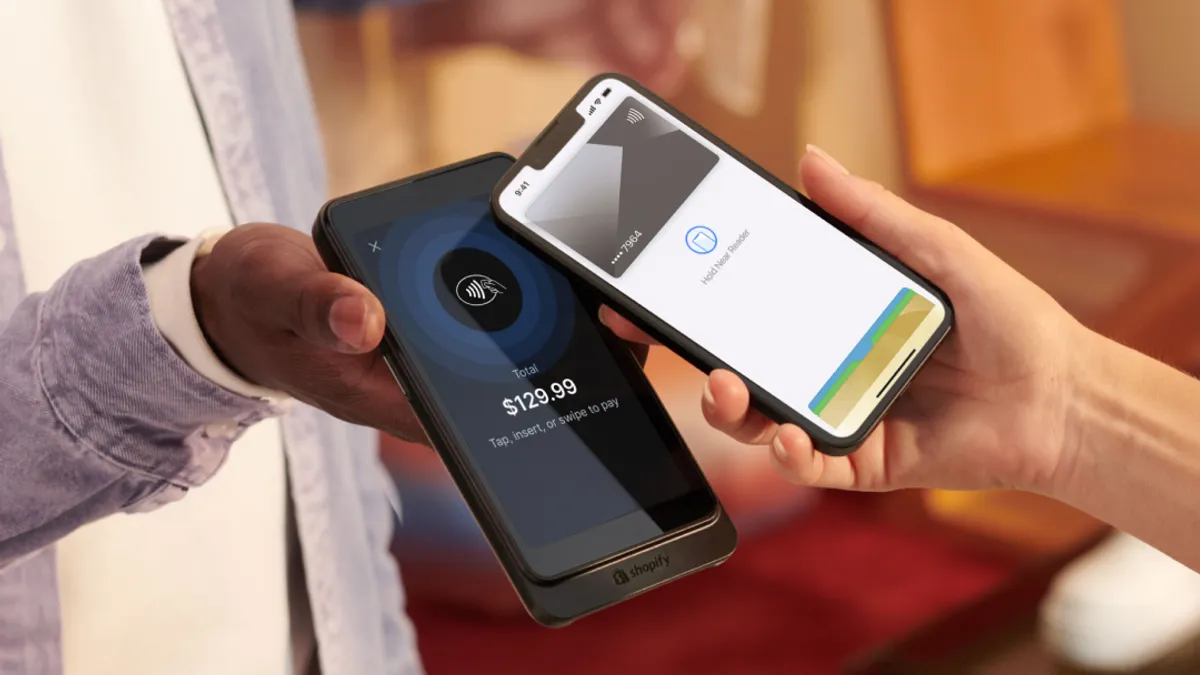Dive Brief:
- Multi-channel commerce company Shopify is launching POS Go, a mobile point-of-sale system that lets sellers transact on the go, according to a Tuesday announcement.
- With POS Go, merchants can accept tap, swipe and chip payments; monitor their sales and inventory; and track product information, customer notes and purchase history, according to the news release.
- The hardware addition comes as e-commerce growth has slowed at this stage of the COVID-19 pandemic. As shoppers have flocked to stores, Shopify said it saw offline sales soar in the first half of the year. In May, brick-and-mortar sales were up 14% over 2019 figures, per Mastercard data.
Dive Insight:
Recognizing the return of in-store shopping, Canadian Shopify said the POS Go system will enable merchants to move seamlessly between e-commerce and in-person transactions. Shopify first launched a card reader in 2017 and added more retail POS hardware in 2019.
In the retail point-of-sale arena, Shopify faces no shortage of competition from rivals such as Block-owned Square, Fiserv’s Clover and Lightspeed. Dutch payments company Adyen has gotten into the hardware game, too: It announced in August it was debuting two mobile POS devices. Startup Podium, a payment processing platform for small businesses, last year raised $201 million and introduced its Podium card readers to collect and manage payments. And tech giant Apple’s Tap to Pay ability — allowing merchants to accept contactless payments directly from an iPhone — is being rolled out by payment processors.
Despite the decline in overall venture capital funding for payments startups in 2022 so far, 76 point-of-sale companies raised $22 billion in Q2 2022, the most of any of the categories, according to a PitchBook analysis released in August. A Juniper Research report released in May 2021 predicts that point-of-sale terminals will process more than $17.3 trillion worldwide in 2026, up from $14.8 trillion in 2021.
Along with its hardware offerings, Shopify has focused on social commerce and adding partners. In February 2021, the platform integrated its Shop Pay tool into Facebook and Instagram, allowing Shopify merchants to accept payments via its Shop Pay features. YouTube teamed up with Shopify in July to let YouTubers link to their Shopify store on their YouTube channels.
Shopify also has tried to court online creators and big-name brands. In April, luxury fashion group Lanvin Group began using Shopify to create a new e-commerce platform in North America. Last month, Shopify introduced a shoppable content feature that connects creators with merchants.
As Shopify adds new features and attracts partner companies, the company has reported net losses in the first and second quarters of this year. In July, Shopify also cut 10% of its employees, a move it made due to a miscalculation of e-commerce growth, according to a company blog post.
Despite those losses, Shopify bought Deliverr for about $2.1 billion in May to add end-to-end logistics to its platform and accelerate the development of its fulfillment network. Shopify had been building up its fulfillment operations before the pandemic disrupted the retail industry.










